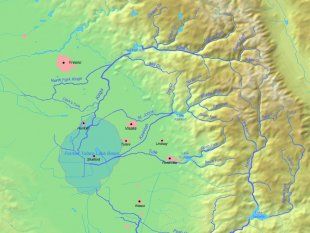
© Unknown
At least one California town has gone dry, and many are expected to follow soon. East Porterville, in Tulare County is now without water, as the wells that feed it have dried up. Residents, according to Yahoo! News, now have to
drive to the local fire station to get water to drink, bathe, and flush the toilet. And ironically, the town is near what was once the largest freshwater lake in California.
Tulare County, which relies heavily on the agricultural industry, is parched. The some 500 wells that feed its residents and farmers have gone dry. And the county says that it may be years and cost $20 million before a new groundwater management program, which includes a hookup between East Porterville and Porterville's water systems, goes into effect.
The county is named for
Tulare Lake, which was once the largest freshwater lake west of the Great Lakes. It was drained for regional agricultural purposes, begining in the early 20th Century. The lake basin is now some of the most fertile
soil in the Central Valley, the most productive agricultural region of the United States. Although dry for the most part, the lake occasionally reappears after unusually high levels of rainfall or snow melt, the last time being 1997.
Earlier this month, a 5,000-gallon-water tank, donated by the county's Sheriff's Association was delivered to East Porterville, and that is primary source of water for this low-income community. Residents now drive to the fire department with empty water jugs and pump water from the tanks to take home. The county has also been supplying free bottled water, paid for by the state, to residents for drinking and cooking.
However, there are worries within the community that the county might use the bottled-water handout to identify undocumented residents or condemn homes that are in disrepair. Non-profit groups and churches have also been trying to help supply water to East Porterville residents.
"It's a disaster," says Andrew Lockman, manager of the Tulare County Office of Emergency Services. "It's not a tornado, it's not a hurricane, it's a quiet disaster."
California is beginning of the fourth year of the megadrought (new water year begin in October), with 2014 being the worst period. For the most part, much lower precipitation rates during the winter months have fueled the drought. Snowpacks have been meager and reservoir levels are at historical lows. Warmer and dryer summers have only exacerbated the problem. Climate forecasters are predicting that megadroughts such as this one are likely the new norm.
Also problematic for California is the state's water distribution system, a vast network of dams, pipelines, and canals that's
more than 90 years old and not capable, even under the best of conditions, of providing sufficient water for the state's growing population. NPR News reports that engineers and politicians agree that a substantial infrastructure upgrade is needed regardless of future water forecasts. Gov. Jerry Brown is currently asking voters to pass a bond, totalling $7 billion, to upgrade the state's water network. Included in this would be two new, massive reservoirs and expansion of many others in the state.
Meanwhile, dozens of communities in the state are reporting they're on the verge of running out of water. Some say they'll have no water in as little as 60 days. Many of the communities that are at the crisis point are small, poor and isolated, often relying on one water source, without backups, to provide for their customers.Currently, 14 communities are on the "critical list," meaning they've informed the state that they've reached a point where they don't believe they will have adequate public water within the next two months. Some of these communities have turned to trucking in water for now while they look for long-term solutions to the drought's ialmpact on their water systems. California's 154 reservoirs are about
50% below their historic average.The U.S. Drought Monitor, a government-funded weekly map of drought conditions, reports that 82% of the state is experiencing a severe to exceptional drought, with 58% suffering from the harshest of drought conditions. The entire state has been suffering from drought conditions since May, the first time in 15 years.
I love it so much. A beautiful place and so mismanaged for so long. Fracking is the latest insult but if you remember the movie "Chinatown" you know that water has been a focal point of criminal activity for a lonnnng time. And this IS the breadbasket for the country and large parts of the world.